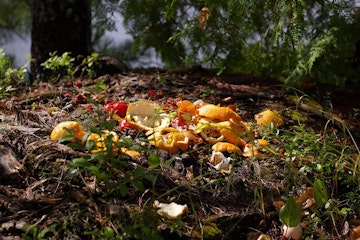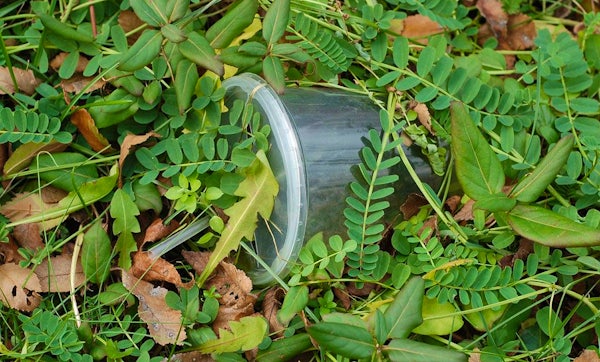In a perfect world a plastic cup would break down as easily and quickly as a piece of fruit. In that same world, many other products would degrade into clean water and fresh air and not into toxins, metals and other harmful substances.
But, we do not live in this type of world and everything we buy, produce or use has some kind of consequence for our environment, whether positive or negative. If you, knowing this, were ever interested in buying a product or packaging which is biodegradable, you might have found yourself confused as to what that term actually means.
To end confusion and know whether certain products are biodegradable and safe for our environment, keep reading to discover the true meaning behind this common yet confusing word.
What does biodegradable mean?
To put it simply, if something is biodegradable it means that in the right conditions and under the influence of certain microorganisms, such as fungi or bacteria, it will eventually break down to its basic components and, hopefully, without leaving any bad toxins in the soil. Unfortunately, sometimes even the materials labelled as “biodegradable” leave chemicals or other damaging substances in the ground as they break down. How is this possible? Most people characterize the word “biodegradable” as eco-friendly. If we take into consideration the fact that even some biodegradable materials produce harmful greenhouse emissions when left to decompose in a landfill, then this definitely does not make them a friend to our environment. As a matter of fact, a waste product ending up in landfill does not have to degrade at all, which makes it a great ally to the greenhouse-gas emissions.
What materials are biodegradable?
For materials to be biodegradable, it is important to look at the environment in which they exist and degrade. Most materials are in fact biodegradable because they can be broken down by the presence of living things, such as microorganisms. Usually, materials such as food waste, wood and paper can biodegrade quite easily. However, we now know that products that will biodegrade in nature may not biodegrade in landfills, since landfills lack enough bacteria, light and water to carry on this process.
In compost heaps, where a large amount of oxygen is present, food waste, paper and even biodegradable plastics will not generate methane. On the other hand, in landfills, biodegradable components break down without oxygen and release two strong greenhouse gases: methane and carbon dioxide. While the carbon dioxide usually stays in the landfill’s ground, methane goes into the atmosphere, adding to global warming.

Even in an average landfill, products can be biodegradable but damaging. Items which decompose at different rates also release methane at different rates and times. Biodegradable plastic generates the most methane gas, followed by office paper, food waste, newspaper and other forms of solid waste. Food waste usually degrades faster than office paper and newsprint, which then degrade faster than biodegradable plastic. To completely break down in a landfill, an apple core takes 1 to 2 months, paper bags take at least a month, tin cans more than 50 years, and for plastic bags and bottles it can take up to hundreds of years.
Nevertheless, some landfills even collect methane that is produced in their landfills and use it to create electricity, but this is not always the case. In those cases, when this is possible, it is better to send biodegradable products to a recycling plant in order to create methane which then can be used to eventually generate electricity.
Is biodegradable the same as compostable?
Many products or packaging are labelled today as "compostable" which many people relate to “biodegradable”, but there are actually differences between the two.
Compostable materials are similar to biodegradable materials in that they are both intended to return to the soil. However, compostable materials have an additional component by providing the earth with nutrients once the product has completely broken down. So, compostable products are indeed biodegradable (only in a composting environment), but biodegradable items are not necessarily compostable.

While biodegradable materials can break down within landfills, compostable materials would need special composting conditions. These types of products do not break down easily in traditional landfills, so compostable products should not be thrown in the trash. Also, unlike biodegradable products, compostable materials leave no toxicity in the soil and decompose in about 90 days. So, not only can these types of products or packaging break down quite quickly, but they can leave behind humus, a nutrient-rich and organic material which makes the ground fertile for new growing purposes.
What should I use/do?
If you want to contribute to the environment protection, before starting your quest for biodegradable products, take one step back and have a look at your personal waste management habits. Before opting for green or biodegradable items, try reducing, reusing and separating your waste.
When buying biodegradable products, start by reading product labels and research online to find out the biodegradability and compostability of the product you need, including how long it takes for that product to break down completely. Also, make sure you understand all product ingredients and try to buy products with natural ingredients.
When it comes to food, if your town does not have any shared composting resources, try starting your own composting process in your own garden. The best part here is that the work is done for you. Let oxygen and healthy bacteria convert your food waste into rich fertilizer that you can later use on your lawn. Remember, if you are kind to nature, then nature can be rich to you.
For more tips on how to go green in your kitchen, read our article here.
